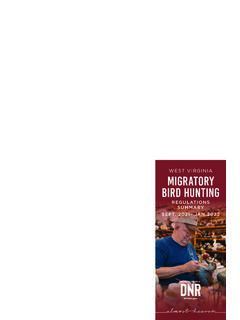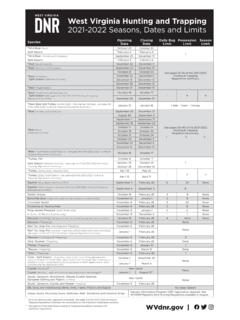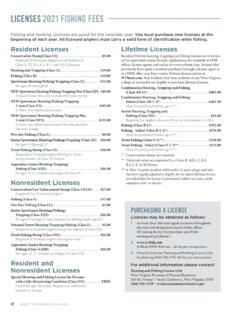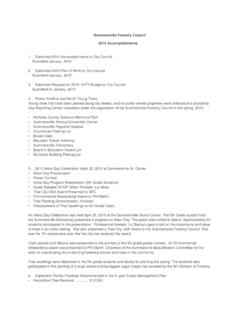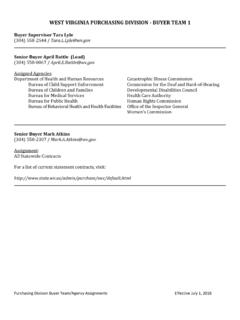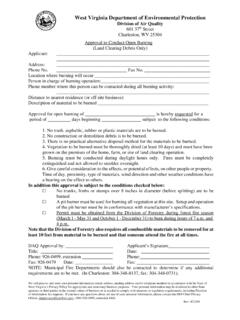Transcription of West Virginia Songbird
1 west Virginia SongbirdForest Management GuidelinesScarlet TanagerT his publication had its genesis with the west Virginia Partners in Flight (WV PIF) Working Group. This organization, part of an international conservation effort, works to identify songbirds and habitats of con-servation concern, facilitate collection of basic life history information of little known species, and promote dissemination of educational and informational material to help the public better understand conservation issues. We would like to thank the contributors listed below as well as the scores of researchers, naturalists and citizen scientists who, through long hours in the field, have provided us with the information to produce this document. Susan Olcott - west Virginia division of Natural Resources, EditorNanci Bross-Fregonara - west Virginia division of Natural Resources, Publication DesignContributors.
2 Jane Bard USDA Forest ServiceBarbara Breshock - west Virginia division of ForestryMark Ford - USDA Forest ServiceJim Fregonara - west Virginia division of Natural ResourcesBill Grafton - WVU Cooperative Extension ServiceDrew Jones - Williams College, MAKathy Leo - west Virginia division of Natural ResourcesPatty Morrison - USDI Fish and Wildlife ServiceKieran O Malley - west Virginia division of Natural ResourcesLynette Otto - USDA Forest ServiceAllen Waldron - west Virginia division of ForestryJo Wargo - USDA Forest ServicePetra Wood - WVU Cooperative Fish and Wildlife Research UnitCover forest images are by Elizabeth Byers, WVDNR; Cover inset photo of a scarlet tanager is a WVDNR archives image. west Virginia Songbird Forest Management GuidelinesTable of ContentsPreface Primer on Habitat Alteration in west Virginia Basic Bird Short Term Effects of a Timber Plans and Contracts Protecting and Enhancing Your and Timber Harvesting Practices Even-age Uneven-aged Intermediate Bird-friendly Timber Harvesting Management Guidelines For west Virginia Habitat west Virginia Logging Sediment Roads and Technical WV PIF Priority Expected Results of Forest Management Checklist of west Virginia s Breeding Bird west Virginia , with 78 percent of its land area covered by forests, is the third most densely wooded state in the nation behind Maine and New Hampshire.
3 Its timber resources are larger in size than they have been for the past 100 years. Although west Virginia s forests and forest products have great economic importance, they also provide recreational op-portunities, scenic views, fresh air and clean water. Most importantly, these forests provide invaluable habitat (for unfamiliar terms see Glossary starting on page 33) for thousands of plants and animals. Seeing and conserving wildlife are among the most cited reasons landowners give for owning, main-taining and managing their that their woodlots are mature and have substantial value, many landowners are consid-ering a harvest but are concerned about how the har-vest will affect wildlife. This publication examines the relationship between harvesting intensity and its effect primarily on songbirds , although the impacts on other wildlife is mentioned as well.
4 We hope that this document will give landowners and land manag-ers the additional information they need to develop comprehensive land management plans that meet not only silvicultural and aesthetic expectations, but also provide healthy and diverse forests to be passed on to succeeding : songbirds and Population DeclinesMost people do not realize that the majority of birds in west Virginia are migratory, spending the winter in the southern United States, the Carib-bean, Central and South America and raising their young here during the summer. west Virginia is important in the conservation of many species of songbirds that are declining elsewhere. Because of our extensive forest lands, those species that require large tracts of forests for breeding find habitat here.
5 west Virginia hosts significant breeding populations of the cerulean warbler (27 percent of the world s breeding population), worm-eating warbler (20 percent) and Louisiana waterthrush (19 percent). west Virginia also serves as a source of these species and others that, due to habitat loss, have declining populations. These other areas are termed sinks; breeding populations may exist there, but the production of young is so low that the populations are unable to sustain themselves without the addi-tion of individuals from the outside, such as from west Virginia . Population declines have been noted in many species of birds since the 1960s. Although the reasons behind the declines are numerous, several major ones stand out: west Virginia is host to approximately 20 percent of the world s breeding population of worm-eating and Bob WoodUS Forest Service ArchivesEarly days of logging in the Monongahela National and Introduction Permanent or longterm destruction and degradation of habitat on breeding, stopover and wintering areas has created the most pressure on migratory birds.
6 On breeding grounds, road construction and surface mining combined with commercial and residential development has resulted in fewer places for many species to raise their young. Slash and burn agriculture and clearing for pas-tures and com-mercial develop-ment in tropical wintering areas, especially Cen-tral America, has diminished tropical rain forests to a fraction of their former area, relegating many species of returning migrants to marginal habitat and increased competition with resident tropical species. Coastal development for resorts, second homes and industry endangers migrating birds by decreasing required stopover areas for resting and feeding during migration. Fragmentation, the breaking up of large blocks of continuous habitat into smaller ones, has made many areas unsuitable or marginal for spe-cies that require large expanses of similar habitat (area-sensitive species).
7 Fragmentation creates edge, the transition zone between one habitat type and another. In west Virginia this edge is typi-cally between a forest and a field. This transition zone may be soft and consist of wildflowers, shrubs and small trees, or it may be hard with an abrupt transi-tion between grasslands next to large trees. Soft edge habitat is valuable for many species of birds such as song sparrows, common yellowthroats and indigo buntings. But both soft and hard edges provide rich hunting grounds for a variety of predators, such as raccoons and crows, because of the close proximity of the two habitat types. If a landscape is highly fragmented (see photo below), forest patch size is small. The smaller the patch, the more it is influenced by edge ef-fects.
8 Many interior forest species are not adapted to predators at the edge and their nests are easily found by predators, resulting in very low repro-duction and eventual population decline. This increased predation is due to the edge effect. Spe-cies, such as the song sparrow, that are adapted to the edge have nesting strategies that hinder the edge predators enough to be in balance with predation isn t the only result of a fragmented landscape. Warmer and drier con-ditions at the edge supports the formation of a different insect community, affecting the type or amount of food available to a forest interior spe-cies. In addition, brown-headed cowbirds, which are common in agricultural areas, lay their eggs in other birds nests to hatch and be raised by the host bird, usually at the host brood s expense.
9 Most open land and edge species have some strategies to counter cowbirds, but interior forest birds do not. Vegetative succession is the natural growth of a field into a forest; from grasses to shrubs to saplings to mature trees. Abandoned farmland that is not maintained goes through this process, resulting in the loss of early successional habitats such as fields, old fields and scrub lands. These impor-tant habitats are short-lived, and the bird species that need them for breeding must find suitable, and sometimes very specific, habitat at other loca-tions. Although edge habitat is common, it doesn t occur in large tracts, but typically in nar-row bands. Without manage-ment, early successional habitat grows into forest - a boon for forest breeding species, but a loss to those species requiring relative large expanses of open land, such as the golden-winged warbler or prairie view of forest PhotoUS Forest Service PhotoCoastal development impacts stop-over areas.
10 The need for farms to maximize profits, often to stay in business, has altered farming practices, resulting in more intensive management of the land. The loss of hedgerows and fallow fields, earlier haying, increased pesticide use, the switch to row crops and intensive grazing have all severely affected the breeding and survival of birds that nest in open areas, such as meadowlarks, bobolinks and grasshop-per sparrows. Human induced processes (habitat loss, fragmentation and altered farming practices) coupled with succession and other natural pres-sures on migratory birds such as predation, high deer populations, invasive species and disease, have all contributed to the decline of several species. Not all species are declining, and those that are declining locally may not be declining throughout their range.
